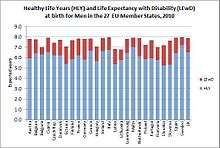Healthy Life Years
The Healthy Life Years indicator (HLY) is a European structural indicator computed by Eurostat. It is one of the summary measures of population health, known as health expectancies,[1] composite measures of health that combine mortality and morbidity data to represent overall population health on a single indicator.[2] HLY measures the number of remaining years that a person of a certain age is expected to live without disability. It is actually a disability-free life expectancy.
History
The European Union has decided to include a small set of health expectancies among its European Community Health Indicators (ECHI) to provide synthetic measures of disability, chronic morbidity, and perceived health. Therefore the Minimum European Health Module (MEHM), composed of 3 general questions covering these dimensions,[3] has been introduced into the Eurostat EU-Statistics on Income and Living Conditions Survey (EU-SILC)[4] to improve the comparability of health expectancies between countries. In addition life expectancy without long term activity limitation, based on the disability question, was selected in 2004 to be one of the structural indicators to be examined every year, during the European Spring Council for assessing the EU strategic goals (Lisbon Strategy) under the name of “Healthy Life Years” (HLY).[5] Furthermore the European Union is co-funding a Joint Action on Chronic Diseases and Promoting Healthy Ageing across the Life Cycle (CHRODIS-JA).[6] This aims to promote and facilitate a process of exchange and transfer of good practices between European countries and regions, addressing chronic conditions, with a specific focus on health promotion and prevention of chronic conditions, multi-morbidity and diabetes.
Detailed information on the Health Expectancies in Europe are available from the EurOhex Advanced research on European health expectancies[7] while latest Healthy Life Years values can be found on the general public website devoted to the Healthy Life Years.[8]
Context
Dramatic increases in life expectancy in the most developed countries - and therefore in the countries of the European Union - constitute one of the most remarkable advances of the last decades. But why prolong life if this is to be accompanied by increases in severe mental and physical impairment? Thus a further challenge confronts the European Community:
- increasing life expectancy in good health.
In this context, the classical mortality indicators are no longer sufficient to monitor the health status of European populations. The availability of health expectancy indicators dividing life expectancy into life spent in different states of health is useful to health authorities in the field of public health and health policies provided that these indicators allow comparisons over time and between geographic areas and between socio-economic groups in society. As the post-war generation reaches retirement, the pace of ageing will increase dramatically in our European societies, with profound social effects. HLY is an important indicator :
- Health of a population is inherently difficult to measure because it is often defined differently among individuals, populations, cultures, and even across time periods.
- Many studies focus on measures such as physical impairment or disability in functional tasks or presence of a specific chronic disease. Self-assessed health, being much more global and subjective in nature, can incorporate a variety of aspects of health including cognitive and emotional as well as physical status, and therefore provide insights into the needs of an ageing society. Hence, self-assessed health measures as HLY may be a particularly important indicator of the potential demand for health services and long-term care needs.
- The two components of the calculation of the HLY are life tables and self-perceived disability assessed by health surveys. From 1995 to 2001, data from the Eurostat European Community Household Panel (ECHP) survey have been used for the EU-15 Member States. Its successor, the Eurostat EU-SILC has been used from 2005 onwards for the EU-25 and then 27 Member States.
Example

- The HLY estimates are provided for the 27 EU Member States using the EU-SILC data for 2010 (see graph above)
- The first analyses of the healthy life years values disclose significant inequalities among the European countries.[9]
See also
References
- ↑ Glossary EurOhex website
- ↑ J.-M. Robine. Summarizing health status. In: Pencheon D,Guest C,Melzer D,Gray JAM, editors. Oxford Handbook of Public Health Practice. 2nd ed. Oxford: Oxford University Press; 2006. p. 160-168
- ↑ B. Cox, H. Van Oyen, E. Cambois, C. Jagger, S. Le Roy, J-M Robine, I.Romieu. The reliability of the Minimum European Health Module. International Journal of Public Health 2009;(54):55-60 (DOI 10.1007/s00038-009-7104-y), p57
- ↑ Regulation (EC) No 1177/2003 of the European Parliament and of the Council of 16 June 2003 concerning Community statistics on income and living conditions (EU-SILC)
- ↑ Health Life Years in the core of the Lisbon Strategy
- ↑ http://www.chrodis.eu/
- ↑ EurOhex
- ↑ healthy-life-years.eu
- ↑ C. Jagger, C. Gillies, F. Mascone, E. Cambois, H. Van Oyen, W.J. Nusselder, J.-M. Robine, EHLEIS team. Inequalities in healthy life years in the 25 countries of the European Union in 2005: a cross-national meta-regression analysis. The Lancet 2008;372(9656):2124-2131 (DOI 10.1016/S0140-6736(08)61594-9)
- J.-M. Robine, C. Jagger, Euro-REVES group. Creating a coherent set of indicators to monitor health across Europe: the Euro-REVES 2 project. European Journal of Public Health 2003;13(3):6-14.
External links
- Healthy Life Years
- EurOhex
- Europa - Public Health
- Heidi Wiki
- REVES, the International Network on Health Expectancy and the Disability Process
- US Healthy People
- WHO | World Health Organization
- Health-EU Portal the official public health portal of the European Union
- UK Health Success